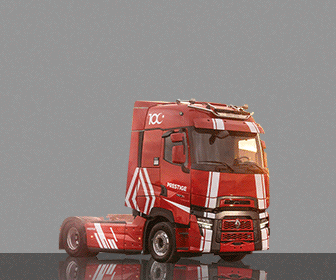REGISTRATIONS
THE EUROPEAN UNION
In 2019, new commercial vehicle (CV) registrations in the EU increased by 2.5% to 2,546,830 units, the seventh consecutive year of growth. Demand was largely driven by the van segment, which made up 83% of CV registrations in the EU.
During the year, each of the five key markets in the region made positive contributions to some extent. Germany delivered the highest percentage gain (+6.1%), followed by France (+4.3%), the UK (+3.0%) and Italy (+1.9%). Spain recorded the poorest performance, with registrations in the country increasing by only 0.3%.


Vans
New light commercial vehicle registrations in the EU reached 2.1 million units in 2019, a 2.8% year‐ on‐year increase. The introduction of the new WLTP emissions test for vans in September 2019 accelerated registrations during the summer months, with a subsequent slowdown from September to November. However, in December this ceased to be a factor, as demand for vans increased again.
The five big EU markets all posted gains during 2019, with Germany (+6.9%) and France (+4.5%) making a significant contribution to the region’s growth during the year.

Trucks
The truck segment, covering medium and heavy commercial vehicles over 3.5 tonnes, increased slightly by 0.9% to 388,342 units in 2019. This growth was generated in the first half of the year, as registrations fell for six consecutive months from July. The introduction of obligatory tachographs in heavy trucks from 15 June 2019 resulted in a decline of heavy‐truck registrations, which represent the bulk of total truck demand.
The United Kingdom (+9.5%), Germany (+4.2%), France (+1.5%) and Spain (+1.1%) all improved over last year. Italy (‐7.6%) was the only key EU market where demand for trucks fell.

Buses
During 2019, new bus and coach registrations increased by +1.8% in the EU, in spite of the negative performance of the segment during the second half of the year.
The Central European countries provided a strong boost (+5.1%) to the full‐year total. Among the major Western European markets, only France (+8.8%) made a positive contribution.

PRODUCTION
WORLD
Commercial vehicle output on the European continent posted a 3.0% decline in 2019, with 3.5 million units built in total. Declining domestic demand in both Russia and Turkey saw local production fall. Manufacturing activity also slowed in the EU as a result of a weaker economic environment. Looking at the five major EU markets, commercial vehicle production rose only in Spain; production shrank in Germany, France, Italy and the UK last year.
North America’s commercial vehicle output expanded by 3.6% in 2019, driven by high production volumes of pickup trucks. In total, some 4.7 million units were manufactured.
The protracted trade dispute between China and the United States, combined with the economic slowdown, undermined consumer confidence and affected vehicle output in China. As a result, Chinese production18 declined by 1.7% in 2019, with 5.3 million units built.
Commercial vehicle production in Japan and South Korea remained more or less stable at 1.5 million units in 2019, or 0.7% lower than 2018.
Full‐year 2019 commercial vehicle production in South America fell sharply (‐10.1%). The deteriorating economic situation in Argentina negatively affected Brazilian commercial vehicle production, which is focused on meeting domestic demand and exports throughout Latin America, particularly Argentina.
Following strong 2018 results, production in South Asia saw a sharp slowdown in 2019 (‐15.4%) due to weakening demand in Thailand and Indonesia.
Finally, commercial vehicle output in the Middle East and Africa dropped by 6.4% in 2019, as Iranian production declined following the escalation of the US‐Iran conflict.

TRADE
Though 2019, the total value of commercial vehicle and bus exports increased significantly (+9.5%), creating a trade surplus of more than €2.5 billion for the European Union.
The truck and bus segments were largely responsible for sustaining this growth, with both imports (+10.6%) and exports (+21.7%) posting double‐digit gains compared to 2018. Together, these two vehicle segments alone generated a €4.8 billion trade surplus in 2019.
However, exports of light commercial vehicles declined slightly last year, with van imports outstripping exports by €2.3 billion.

IMPORTS
Turkey maintained its position as the leading country of origin for EU commercial vehicle imports in 2019, despite the value of imports remaining virtually unchanged since the year before.
Throughout 2019, commercial vehicle imports from most of the EU’s main trading partners increased substantially in value terms, most notably those from South Africa (+85.2%), China (+57.1%), Switzerland (+34.5%) and Norway (+28.5%).
However, the value of commercial vehicles exported to the EU from the United States and India sharply declined (down by 20.9% and 61.9% respectively) during the same period.

EXPORTS
The overall value of EU commercial vehicle exports to Norway (+45.2%), China (+26.5%) and Saudi Arabia (+133.4%) increased significantly in 2019. Norway is now the main export destination for EU‐ made commercial vehicles and buses, and – together with Switzerland and China – accounted for more than 30% of the total value of EU exports in the sector in 2019.
At the same time, the value of exports to Australia (‐32.0%), Turkey (‐30.8%) and the United States (‐28.0%) contracted strongly last year.





